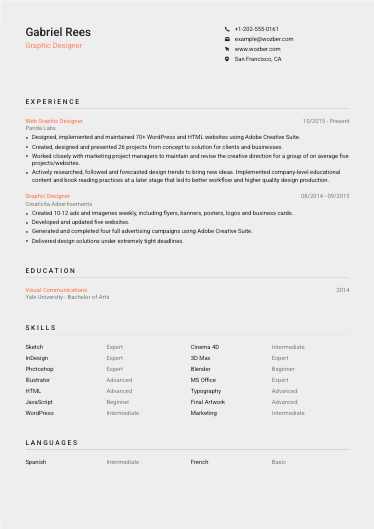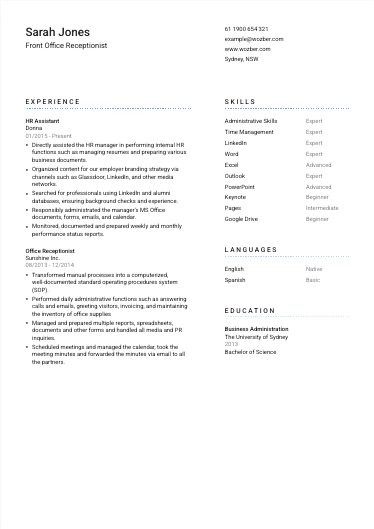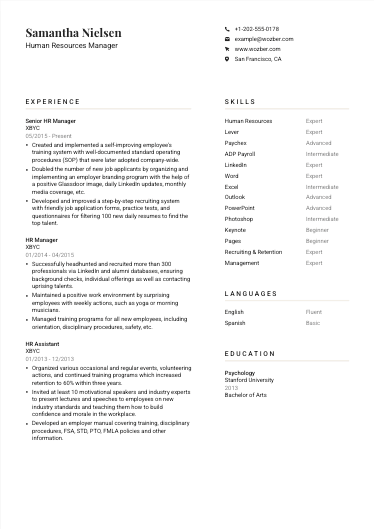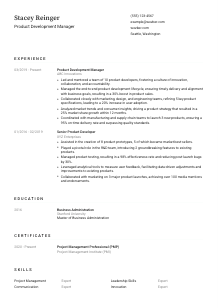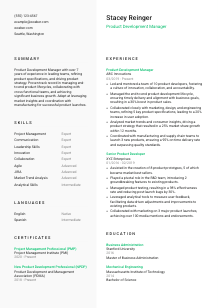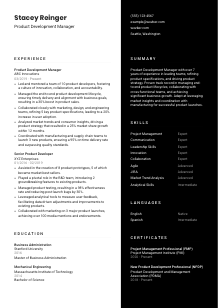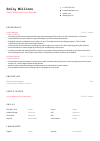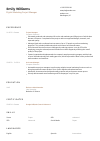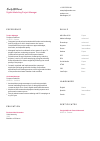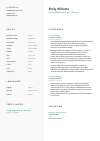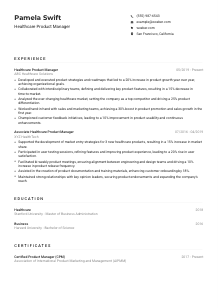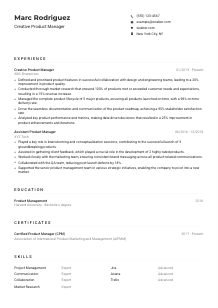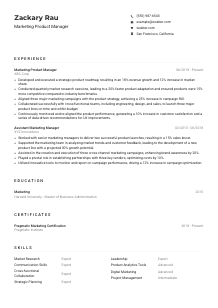Product Development Manager Resume Example
Driving product innovations, but your resume seems static? Explore this Product Development Manager resume example, shaped with Wozber free resume builder. See how smoothly you can articulate your inventive prowess to match job intricacies, progressing your career on the same dynamic trajectory as your groundbreaking creations!
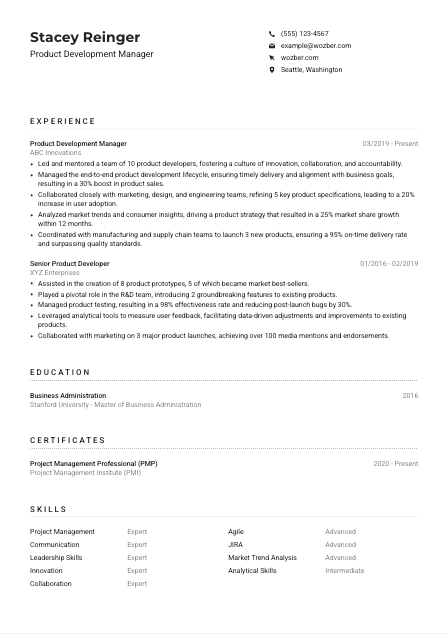
How to write a Product Development Manager Resume?
Ready to forge ahead in your product development career but feeling like your resume isn't quite selling your expertise? As a Product Development Manager, your resume is a critical tool in showcasing your ability to innovate, lead, and bring products from concept to commercialization. Leveraging Wozber's free resume builder, this guide is your blueprint to a resume that resonates with hiring managers, making full use of ATS-friendly resume templates and ATS optimization tools. Embrace this journey to create a resume that not only ticks all the boxes but tells your unique story in the competitive world of product development.
Personal Details
Your voyage to the top begins with the basics, but don't be fooled by their simplicity. Personal details can set the stage for your professional narrative, making it crucial to sculpt this section with precision for the Product Development Manager role. Let's ensure this part of your resume is sharp, professional, and perfectly aligned with what hiring managers are looking for.
1. Make Your Name POP
Your name is the banner under which your professional achievements march; make sure it stands proudly at the top of your resume. Consider a font that's clean and authoritative, ensuring it's prominently displayed so it makes an instant impact.
2. Sync with Your Target Role
Place the job title "Product Development Manager" directly beneath your name, as if it's already yours. This not only shows your clear intent but also aids in ATS optimization by aligning with the job title right off the bat.
3. Make Contact Details Count
Your phone number and email should be your lifelines, always accurate and professional. A misspelled email or an old phone number can cost you a great opportunity. Hint: a professional email format typically includes your first and last name.
4. Address Your Location Strategically
Being in Seattle, Washington, aligns perfectly with the job's requirements – highlight this in your resume. It reassures the hiring manager of your readiness and suitability in terms of logistics.
5. If Relevant, Add Your LinkedIn
In today's digital age, a LinkedIn profile acts as your career's online portfolio. Including it, if it's polished and mirrors your resume, adds depth to your application and provides a portal to your professional world.
Takeaway
The personal details section is your handshake in the digital realm, the point of first contact that sets the tone for the rest of your resume. Crafted correctly, it ensures that you start off on the right foot, presenting a professional, polished image right from the beginning. Remember, simplicity combined with strategic placements makes for an impressive introduction.





Experience
The Experience section is where your resume really begins to take shape. For a Product Development Manager, this is where you demonstrate your capability to lead from the front, turning innovative ideas into market realities. Let's dive into how to construct this section to reflect your strategic and leadership abilities in product development, making every word pitch for your potential.
- Led and mentored a team of 10 product developers, fostering a culture of innovation, collaboration, and accountability.
- Managed the end‑to‑end product development lifecycle, ensuring timely delivery and alignment with business goals, resulting in a 30% boost in product sales.
- Collaborated closely with marketing, design, and engineering teams, refining 5 key product specifications, leading to a 20% increase in user adoption.
- Analyzed market trends and consumer insights, driving a product strategy that resulted in a 25% market share growth within 12 months.
- Coordinated with manufacturing and supply chain teams to launch 3 new products, ensuring a 95% on‑time delivery rate and surpassing quality standards.
- Assisted in the creation of 8 product prototypes, 5 of which became market best‑sellers.
- Played a pivotal role in the R&D team, introducing 2 groundbreaking features to existing products.
- Managed product testing, resulting in a 98% effectiveness rate and reducing post‑launch bugs by 30%.
- Leveraged analytical tools to measure user feedback, facilitating data‑driven adjustments and improvements to existing products.
- Collaborated with marketing on 3 major product launches, achieving over 100 media mentions and endorsements.
1. Decipher the Job Requirements
Start with a laser focus on the job requirements. For instance, leading cross-functional teams and managing the product lifecycle are core to the role. Each point you jot down should reflect your contributions towards these key areas.
2. Present Your Professional Journey
List your roles in reverse chronological order, spotlighting not just your titles but the evolution of your responsibilities. This trajectory demonstrates progression and growth, making you a more compelling candidate.
3. Tailor Your Achievements
Each bullet point should echo the role's responsibilities. For a Product Development Manager, showcasing how you've fostered innovation or streamlined the product development process can turn a good resume into an exceptional one.
4. Quantify Your Impact
Numbers speak louder than words. A ‘30% boost in product sales' or ‘leading to a 20% increase in user adoption' provides tangible proof of your effectiveness and sets you apart from the competition.
5. Relevance is Key
While it's interesting to know you led the annual corporate retreat, focus on experiences that demonstrate your expertise in product development. Each point you list should serve a purpose: to showcase you as the ideal candidate for the role.
Takeaway
By meticulously crafting your experience section to reflect your achievements and impact in product development, you're not simply listing your past roles; you're telling the story of a seasoned professional ready to take on the challenge of Product Development Manager. This section is your proof of competence and confidence, making it compelling for anyone who sees it.
Education
In the complex, ever-evolving field of product development, your education forms the bedrock of your expertise. It's not just about where you studied, but what you've learned, and how those learnings have shaped you into the product development maestro you are today. Sculpting this section to meet the job's requirements shows you have the academic foundation to back up your practical achievements.
1. Identify Educational Essentials
First, ensure your educational credentials meet or exceed the job requirements. A Bachelor's in Engineering or a Master's in Business Administration directly relates to the expected background for a Product Development Manager.
2. Structure with Elegance
Layout your academic credentials clearly. Start with your most recent degree, including the field of study, the institution, and your graduation year. This organized approach makes it easy for hiring managers to verify your qualifications.
3. Tailor Degree Details
Highlighting your Master of Business Administration or Bachelor of Science in Mechanical Engineering, as in our example, shows you have both the technical and business acumen vital for a Product Development Manager.
4. Courses and Projects - A Selective Showcase
If specific courses or projects are directly relevant to the job or demonstrate your skill set, include them. They can be particularly persuasive in illustrating your readiness for the role, especially in technology or design-centric product development.
5. Academic Achievements and Memberships
While these may become less pivotal the further you move in your career, for someone on the cusp of leadership, showcasing notable achievements or relevant professional memberships can add an extra dimension to your candidacy.
Takeaway
Crafting an education section that speaks to your foundation in both the theoretical and practical aspects of product development sets the stage for understanding your skills and capabilities. It demonstrates not just where you've come from, but the robust knowledge base you bring to the Product Development Manager role. A well-crafted education section is the proof of your lifelong commitment to learning and excellence in your field.
Certificates
In the competitive world of product development, certificates serve as badges of your commitment to continuous learning and mastery of your craft. Whether it's a PMP or NPDP, each certificate you list tells a story of dedication and expertise. Let's make your certificates work for you, highlighting your proactive approach to professional growth.
1. Sift Through the Job Specs
"Certification in Project Management Professional (PMP) or New Product Development Professional (NPDP) is preferred." This direct pull from the job description underlines the value of related certifications. It's a clear indicator of what to feature prominently in your resume.
2. Selectively Showcase Certificates
While the temptation to list every certificate you've earned can be strong, focus on those most relevant to the Product Development Manager role. Quality trumps quantity, making your commitment to the field unmistakable.
3. Date Your Achievements
The currency of your knowledge is crucial in a fast-evolving field. Note the dates of your certifications to demonstrate your up-to-date expertise and ongoing commitment to your professional development.
4. Keep the Momentum
The professional landscape is always shifting. Stay ahead by regularly updating your certifications and seeking out new learning opportunities, especially those that align with the cutting-edge of product development.
Takeaway
Certificates aren't just feathers in your cap; they're powerful indicators of your initiative and capacity to stay at the forefront of product development. By curating your certificates to reflect your most relevant achievements, you not only prove your qualifications but also your dedication to excellence and innovation.
Skills
For a Product Development Manager, the skills section is your arsenal, equipped with both the soft skills and the hard skills critical to your role. This is where you showcase your proficiency in project management, your flair for collaboration, and your innovative mindset. Let's delve into tailoring this section to become a potent summary of your professional capabilities.
1. Extract Key Skills from the Job Description
Analyze the job posting to identify both the stated and implied skills required. Being proficient in "project management methodologies, tools, and software, such as Agile and JIRA," is a concrete starting point. Your resume skills should mirror these requirements.
2. Match Your Skillset
Prioritize your skills to reflect the job description. As a Product Development Manager, your leadership, communication, and analytical skills are as important as your technical abilities. This alignment ensures your resume resonates with the job's expectations.
3. Keep It Organized and Impactful
List your skills in a way that's easily digestible at a glance. Utilize bullet points or a structured format to present a clean, uncluttered view of your capabilities, making sure every skill listed underscores your suitability for the Product Development Manager position.
Takeaway
By strategically selecting and presenting your skills, you make a compelling case for your candidacy as a Product Development Manager. This section is your opportunity to confirm at a glance that you're not just a fit for the position—you're a standout choice. The right mix of skills, presented succinctly, can be the key that unlocks your next career opportunity.
Languages
In the realm of product development, where markets are increasingly global, language skills can be an unexpected asset. They reflect cultural awareness and the ability to communicate in diverse environments. Here's how to align your language prowess with the necessities of the job, potentially setting you apart as a candidate with truly global potential.
1. Address the Job's Linguistic Needs
The job specification underlines the importance of "clear communication in English." This is non-negotiable. Highlighting your native or fluent proficiency in English directly responds to a core requirement of the role.
2. Rank Languages by Relevance
If you speak additional languages, list them in order of their potential relevance to the job. While not a primary requirement, additional languages can showcase your versatility and readiness for roles with a broader, possibly international scope.
3. Be Honest About Your Proficiency
Misrepresenting your language skills can lead to awkward situations. Clearly state your proficiency levels—native, fluent, intermediate, or basic. This honesty ensures expectations are set correctly and demonstrates integrity.
4. Consider the Role's Scope
Even though the primary requirement might be proficiency in English, additional languages speak to your capability to engage in diverse teams and markets. They subtly suggest your readiness for challenges beyond the immediate scope of the job.
5. Assess the Cultural Fit
Beyond mere communication, language skills can be indicative of cultural understanding. In product development, where consumer insight and market trends are paramount, this can be a valuable asset, making you an even more compelling candidate.
Takeaway
Offering a glimpse into your global mindset and cultural adaptability, the Languages section, though often brief, has the potential to add an intriguing layer to your profile. In today's interconnected world, your linguistic capabilities are not just a personal asset; they're a professional strength. Showcase them with clarity and confidence.
Summary
The Summary section is your moment in the spotlight, a concise but powerful narrative encapsulating not just what you do, but who you are as a professional. For a Product Development Manager, it's an opportunity to highlight your innovative spirit, leadership qualities, and your strategic approach to product lifecycle management. Crafting this section with care sets a compelling tone for your entire resume.
1. Capture the Essence of Your Professional Identity
Begin with a holistic statement about your professional self. It could start something like, "With over 7 years of experience in leading product development teams..." instantly establishing your credibility.
2. Spotlight Relevant Skills and Achievements
Dive into the specifics of what makes you exceptional. Mention key skills and accomplishments, aligning them with the job requirements. Quantifiable achievements, such as driving a '25% market share growth within 12 months,' make your summary impactful.
3. Make It Memorable but Concise
Your goal is to leave a lasting impression while maintaining brevity. Aim for 3-5 compelling lines that encapsulate your professional essence. It's your elevator pitch—make every word count.
4. Customize for the Role
Ensure your summary not just details your qualifications but also mirrors the priorities of the role you're applying for. This targeted approach demonstrates your understanding of the role and your direct suitability for it.
Takeaway
The Summary is more than an introduction; it's your professional anthem. It sets the tone for your resume, enticing hiring managers to delve deeper into your experience and achievements. Constructed meticulously, it assures them from the start that you're not just a candidate for the Product Development Manager position; you're the candidate they've been seeking. Let your summary shine, reflecting the full spectrum of your professional prowess.
Launching Your Product Development Manager Journey
Congratulations on taking this critical step toward your next great career move! Armed with insights and strategies from Wozber's free resume builder, including an ATS-friendly resume format and an ATS resume scanner for optimization, you're well-equipped to create a resume that beautifully encapsulates your Product Development Manager expertise. This isn't just any resume; it's your professional manifesto, tailored and primed to launch you into your next role. Let it serve as the bridge between your talent and your ambitions.
The path ahead is bright. Go forth and innovate!

- Bachelor's degree in Business, Engineering, or related fields with a minimum of 5 years of experience in product development or a Master's degree with a minimum of 3 years of experience.
- Proven track record in leading cross-functional teams and driving product development from concept to commercialization.
- Strong proficiency in project management methodologies, tools, and software, such as Agile and JIRA.
- Exceptional communication, interpersonal, and leadership skills, with the ability to effectively collaborate and influence across departments.
- Certification in Project Management Professional (PMP) or New Product Development Professional (NPDP) is preferred, but not required.
- Ability to communicate clearly in English is essential.
- Must be located in Seattle, Washington.
- Lead and mentor a team of product developers, fostering a culture of innovation, collaboration, and accountability.
- Manage the end-to-end product development lifecycle, ensuring timely delivery and alignment with business goals.
- Collaborate closely with marketing, design, and engineering teams to define and refine product specifications, features, and designs.
- Analyze market trends, consumer insights, and competitive landscapes to drive product strategy and roadmap.
- Coordinate with manufacturing and supply chain teams to ensure cost-effective production, quality standards, and timely product launches.

